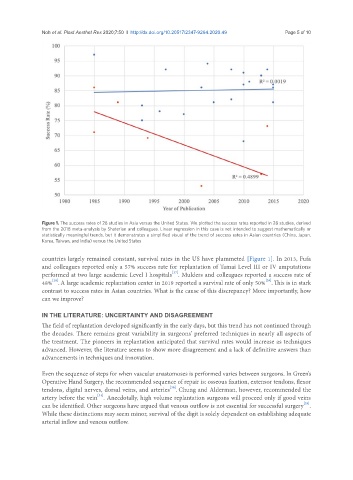Page 579 - Read Online
P. 579
Noh et al. Plast Aesthet Res 2020;7:50 I http://dx.doi.org/10.20517/2347-9264.2020.49 Page 5 of 10
Figure 1. The success rates of 28 studies in Asia versus the United States. We plotted the success rates reported in 28 studies, derived
from the 2018 meta-analysis by Shaterian and colleagues. Linear regression in this case is not intended to suggest mathematically or
statistically meaningful trends, but it demonstrates a simplified visual of the trend of success rates in Asian countries (China, Japan,
Korea, Taiwan, and India) versus the United States
countries largely remained constant, survival rates in the US have plummeted [Figure 1]. In 2013, Fufa
and colleagues reported only a 57% success rate for replantation of Tamai Level III or IV amputations
[27]
performed at two large academic Level I hospitals . Mulders and colleagues reported a success rate of
[29]
[28]
48% .A large academic replantation center in 2019 reported a survival rate of only 50% .This is in stark
contrast to success rates in Asian countries. What is the cause of this discrepancy? More importantly, how
can we improve?
IN THE LITERATURE: UNCERTAINTY AND DISAGREEMENT
The field of replantation developed significantly in the early days, but this trend has not continued through
the decades. There remains great variability in surgeons’ preferred techniques in nearly all aspects of
the treatment. The pioneers in replantation anticipated that survival rates would increase as techniques
advanced. However, the literature seems to show more disagreement and a lack of definitive answers than
advancements in techniques and innovation.
Even the sequence of steps for when vascular anastomoses is performed varies between surgeons. In Green’s
Operative Hand Surgery, the recommended sequence of repair is: osseous fixation, extensor tendons, flexor
tendons, digital nerves, dorsal veins, and arteries . Chung and Alderman, however, recommended the
[30]
[31]
artery before the vein . Anecdotally, high volume replantation surgeons will proceed only if good veins
can be identified. Other surgeons have argued that venous outflow is not essential for successful surgery .
[29]
While these distinctions may seem minor, survival of the digit is solely dependent on establishing adequate
arterial inflow and venous outflow.

